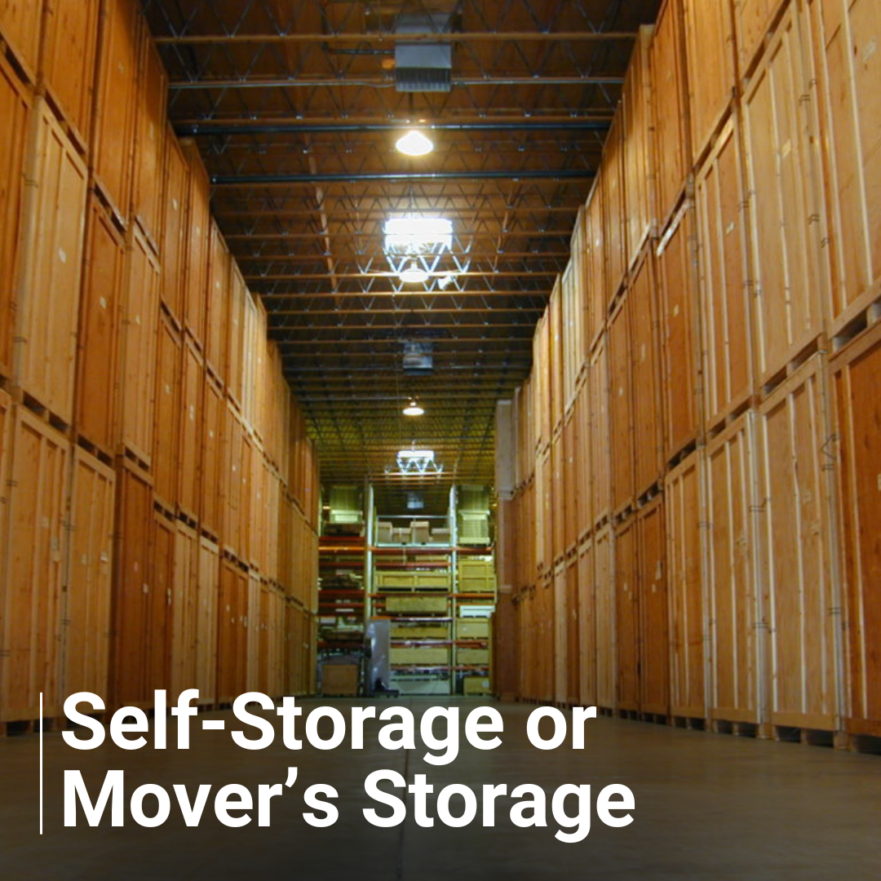There are times during a move when you need the calendar to stretch a little, or maybe a lot, to coordinate your date schedule. Self-storage units and mover’s storage offer an option to coordinate the move-out and move-in dates that best suit your plans. So, what are the pros and cons of those two storage options? We’re glad you asked! Each storage method has some unique benefits, risks, and costs. Let’s explore what’s going to be best for your move. After all, the warehouse you select will be the home for everything you own for a week, a month or two, or maybe longer. Making the right choice is important.
Self-Storage – The United States has more self-storage units per capita than any other country in the world. They are popular for storing everything from seasonal decorations to things that were cluttering up the garage or taking up space in the basement. The biggest advantage to a self-storage unit is access, so if you think you will need to get something out of storage while the shipment is there, self-storage offers no-cost access during the facility’s operating hours, sometimes 24/7.
Here’s the downside of storing your stuff in a self-storage unit. People store just about anything in a self-storage unit. Your next-door-storage-neighbor might be storing food that attracts bugs or storing flammables that could put the entire storage complex at risk. Some commercial businesses use self-storage units to keep chemicals or industrial supplies that you might not want next to your clothes and bedding.
Moving things in and out of self-storage will add to your storage cost because of the difficult access of long distances from the truck to your storage unit. What you save in storage fees you might spend in additional labor costs to move in and out so be sure to consider the total cost of this option.
If you are moving with a professional mover, their liability ends when the goods are delivered to your storage unit. It’s important to fully inspect the shipment as it is delivered and note loss or damage because you will not be able to file a claim if the goods are moved after the mover’s delivery. The moving company will also need to remove their protective cloth furniture pads so be sure to have some padding materials on-hand to safeguard the furniture while it’s stacked for storage.
Mover’s Storage – Most moving companies will offer temporary storage of your goods during the move. They offer Storage in Transit (SIT) if you need to store for six months or less, or longer-term storage know as permanent storage, often used by families who move overseas or are building a new home and sold their home early. During a move, if there are delays between when you need to move out and the date your new home is ready to occupy, having the mover hold onto the shipment is a great way to solve that challenge.
Typically, movers only store household goods. Their crews handle and inspect everything that goes into their warehouse so they make sure there are no improperly packed foods that can attract pests, or things like flammables or explosives included in their shipment. Goods are placed into large wooden containers called storage vaults, so your things are separated from other shipments in the warehouse. A descriptive inventory is used to assign a number to each item and track everything as it’s checked in and checked out of the vault.
If your shipment is stored for less than six months, the mover will assume liability for the condition of the goods based on the coverage you declared on the bill of lading. That liability coverage extends all the way through the delivery of your goods. If there is damage when your move is finally delivered, you only need to file one claim since the mover has single-source liability for the shipment from door-to-door including storage.
Your furniture is carefully protected in cloth furniture pads. Movers use those cloth pads abundantly to keep your furniture from being scratched or damaged as they load and unload the storage vaults.
The drawback to mover’s storage is that your goods are not easily accessible. Once everything is loaded into the vaults, it can be expensive to locate and remove a few items. Hourly fees for a crew to unstack your vault, remove the contents and retrieve a few things can add up quickly. If there are items you will need during your stay in temporary housing, ask your mover to set aside those things at the time your goods are place in storage.
MiniMoves® offers storage at any of our 125 terminal locations nationwide. We can delay the delivery of your shipment until the lease starts or the carpet is replaced, or whatever issue keeps you from accepting your goods right away. Call us for a free moving quote today. We can quickly determine the cost of storage if that’s a service you need. If you are moving locally in the Chicago area, we offer short and long-term storage at our headquarters facility. Ask your MiniMoves’ relocation consultant for a no-cost, no-obligation quote for moving and storage service.
Paying for a month of storage is a lot better than renting the wrong apartment or closing on the wrong house. If you need to delay the delivery of your shipment as you work out your housing plans, MiniMoves® has storage options that can help you find just the right timing for your move-in day.





